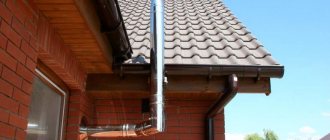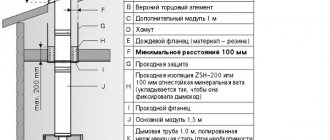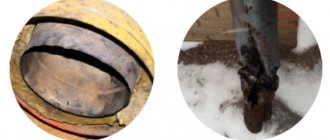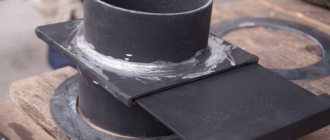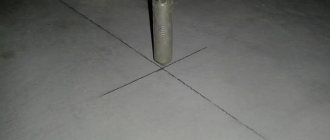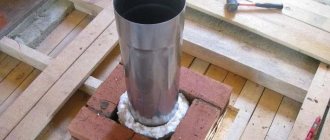- Soot formation
- Method one: cleaning with a brush
- Mechanical method
- Prevention
Often, when the oven is used incorrectly, clogging occurs, which precludes its further use for its intended purpose. Before you clean the pipe in the bathhouse, you should understand the causes of the problem. There are many effective cleaning methods, the choice of each of them depends on the desire of the owner and his financial capabilities.
Checking the technical condition of smoke ducts
First of all, you should definitely make sure that the pipeline is in good condition and intact. When it works intermittently, it is important to determine the reason for its incorrect functioning. The following steps are shown for this:
- visual inspection;
- use of special video systems;
- study of indirect signs that may indicate blockage.
Visual inspection
This is the simplest technique that does not require professional skills. It is enough to disassemble the pipeline and inspect the parts from the inside. If design features do not allow you to remove individual elements, you must take any lighting fixture and lower it into the stove from the roof or through special inspection holes (when provided). If there is a large amount of soot deposits, it will be noticeable even to a layman.
Special video systems
How and with what to clean the chimney pipe in a bathhouse from soot if you don’t want to dismantle the structure, climb onto the roof of the building and contaminate your clothes? You can call specialists with a video system to your home. This option is especially welcome if the stove is complex and has some defective areas. Procedure:
- the device is connected to the PC;
- a chamber with a light element is placed in the oven;
- specialists examine the surface from the inside along its entire length to identify blockages;
- Video recording is carried out, the file is subsequently reviewed, after which the information received is analyzed.
This method is expensive. However, it is important to remember that it is he who will allow us to assess the scale of the problem with one hundred percent probability.
Indirect signs
You can use them as a guide when diagnosing furnace problems:
- decrease in work efficiency - prolonged combustion of firewood;
- smoke entering the house through cracks;
- poor traction;
- presence of black smoke and soot flakes in the air;
- bad smell when lighting wood;
- sudden extinguishing of fire.
Slow kindling
Due to difficult ventilation, smoke quickly fills the entire volume of the chamber, so the firewood burns much more slowly than before. You should hurry to solve the problem, since this sign indicates that the furnace will soon fail.
Smoke comes in
If a smoke smell begins to enter the room through the damper, it is important to stop ignition and clean the stove as soon as possible. It is completely clogged and can no longer function.
Poor traction
You should definitely pay attention to the color of the flame. If all is well, it is bright and shoots upward. Otherwise, it fades and fluctuates in different directions. The draft can be checked using a lit match - bring it to the firebox and follow the flame (it should deviate inward).
Black smoke
It may indicate more than just blockage. Perhaps low-quality firewood was selected, and the solution to the problem will be to select a different fuel.
Soot flakes
The pipe is often clogged if soot flakes fly in the room where the stove is heating. If this problem is not solved in a timely manner, the chimney will become very clogged, and correcting the situation will require a lot of time and enormous labor costs.
Arbitrary flame extinction
Sometimes the fire can go out suddenly. If there is little or no draft, there is not enough oxygen in the firebox. It is strictly not recommended to leave the stove in this condition.
Unpleasant odor during heating
This is what carbon monoxide smells like when it is not being released due to a blockage. This situation requires immediate ventilation and stopping the heating of wood.
When cleaning is necessary
There are several ways to determine when it’s time to clean the chimney.
- Visually determine the traction force. If there is no air flow when the ashpit is open, and the wood burns weakly, then the time has come.
- Observe the smoke coming out when burning dry fuel. If it's clear or has a tint of gray, it's fine. Black soot indicates the formation of a thick layer of carbon deposits.
- With the help of cargo. You need to take a heavy object (a weight, a log, a basketball filled with water) with a diameter close to the chimney, tie it to a cable and lower it into the channel. If the load does not pass through or is covered with soot, then the line is clogged.
In all cases, you should not postpone the task of restoring the functionality of the bathhouse.
First you need to identify the preconditions that caused the problem.
Metal chimneys, their operation and care
Such structures can be single-walled and insulated. The material is resistant to temperature changes, changes in atmospheric pressure, prevents the accumulation of condensation and maintains performance characteristics for a long time. The advantages also include:
- high level of security;
- ease of maintenance;
- durability.
Modern models, which can be found in the Ferrum catalog, are more advanced. They have a special internal enamel coating that protects against rapid clogging. However, all the advantages do not relieve the owners from the obligation to clean it regularly.
Why does the chimney become dirty?
Clogging of the smoke channel occurs during the combustion of fuel, when vapor and solid products are released from it and carried away by the flow of furnace gases. But under certain conditions they do not fly out completely into the chimney. This happens under the following circumstances:
- Burning wet wood. Fuel with a moisture content above 24% contains an increased amount of intracellular moisture, which actively evaporates as it burns. These vapors rise along with the stove gases into the chimney. In a cold or insufficiently heated channel, they mix with cooled air, as a result of which condensation settles on its walls. And this is not just water, because the vapor contains oxidation products, so the sediment is acids. They do not just flow down the walls of the pipe, a significant part of them lingers on the walls, depositing solid combustion products from the smoke, and carbon deposits form on the walls, reducing the cross-section of the smoke channel.
When raw wood burns, it releases excess moisture, which ultimately settles on the walls of the chimney and becomes a source of soot. - Use of prohibited fuel. Of course, there are no direct contraindications, but wood processing waste, consisting of wood with fillers in the form of binders, cannot be used to fire the stove. Such materials include waste plywood, chipboard and fiberboard. Such fuel releases a large amount of tar in the smoke, which intensively settles on the walls of the chimney. Resinous wood - pine or spruce - also has a similar effect.
- Cold chimney. Moisture condensation on the walls occurs at a certain temperature in the channel. This state of gases is called the “dew point”. If such conditions are created inside the smoke channel, condensation settles on its walls in an active mode, provoking the accumulation of soot. To get rid of this phenomenon, you need to reliably insulate the pipe, reducing its heat transfer into the surrounding space. After this, the chimney will warm up, and the dew point will rise higher, leaving the space inside the pipe.
- Presence of horizontal pipe sections. The largest amount of soot forms on the bends of the chimney, so it is better not to use this installation method unless absolutely necessary. If another solution is not possible, cleanouts must be installed on the rotary elbows, which can be opened and free the elbow from soot deposits.
If you need to make a horizontal section on the chimney, the transition to it must be done using an outlet with a special hole for cleaning (revision) - Rough walls of the smoke channel. When constructing a chimney, it is necessary to mop the channel to improve the quality of its surface. Soot is deposited primarily on the uneven surfaces of the chimney.
- Fire the stove with household waste. Such fuel is even more destructive to the chimney than the use of plywood and other scraps. It always contains remnants of plastic or polyethylene packaging, which release a lot of chemicals when burned. In this case, the chimney is guaranteed to become overgrown with soot faster than the heating season ends.
Types of blockages and the need to clean the chimney in a bathhouse
If the oven is not used properly, it will clog. Some problems can be prevented in advance using a set of preventive measures, others are eliminated only when detected. What are the most common causes of clogs?
Soot formation
If the pipe in the attic has not been insulated, drops of moisture may be found on the surface. They absorb the products of wood combustion, after which soot is formed. Gradually, with use, this layer becomes thicker, and over time the stove becomes completely clogged.
Condensation accumulation
If damp wood was used during kindling, a lot of steam will be generated. It disrupts traction and promotes the rapid formation of soot deposits on the internal walls. For this reason, it is important to store wood in a warm, dry place with good ventilation.
Foreign objects getting inside
If the diameter of the smoke channels is large and there is no protective cap, there is a risk of foreign objects getting into it. At first, they do not affect the functioning of the chimney in any way, but over time, as they accumulate, the draft worsens and disappears.
Resin deposition
The type of wood used for kindling greatly influences the blockage. If coniferous wood is used, a lot of resin is produced during combustion; it sticks to the pipe from the inside. Under no circumstances should you burn plastic, plywood fragments, or chipboards. Plum, birch and other deciduous trees are the most suitable options.
Ash accumulation
Designs with many bends and transitions clog much faster than simple ones. If your house has a complex chimney with bent sections, it is recommended to install special hatches in places near the bends, through which it will be convenient to subsequently clean it, removing excess debris.
Main causes of blockages
All chimneys require timely cleaning.
But if clogging occurs at record speed, there may be several reasons for this:
Wet firewood
Wood moisture content above 24% provokes the release of steam during combustion. The steam comes into contact with cold air. Condensation forms, which promotes increased adhesion of solid particles from the smoke to the walls. Higher humidity means plaque forms faster in the pipe.
Junk fuel
Often, bathhouse owners try to save on fuel and use scraps of paper, fabric, pieces of plywood, broken chipboard furniture and other elements. Paints, varnishes, impregnations from these items with a sticky film are layered in the chimney.
Unsuitable wood
It is optimal to use hardwood. Conifers have a high content of resins, which, like chemicals, stick to the walls of the equipment.
Incorrect chimney design
In areas of bends, horizontals, and turns, soot accumulates especially readily. In such places it is necessary to provide hatches for cleaning. The lack of insulation on the street part of the pipe also has a bad effect - the temperature difference contributes to the accumulation of condensation.
It's worth remembering that brick chimneys are more prone to congestion. This is due to the rough texture of the material. They need to be cleaned much more often than metal ones.
Methods for cleaning a chimney
There are many cleansing options. All methods can be divided into 3 large groups:
- mechanical;
- chemical;
- use of folk remedies.
The choice of one type or another depends on the financial capabilities and personal preferences of the owner of the building. They all have both advantages and disadvantages.
Mechanical method
For cleaning, you will need a brush whose diameter exceeds the dimensions of the furnace channels, a strong cable or flexible stick for convenient immersion of the brush, a weighting agent 2 times smaller than the width of the hole. This is the so-called work with a ruff.
Chemical method
How to clean a pipe in a bathhouse if it is clogged, but you don’t want to act mechanically? The chemical method is based on the process of burning certain compounds, leading to the elimination of blockages without damaging the material of the structure. There are many drugs and other agents that act in a similar way.
Kominichek
Used to prevent clogging. It operates on the principle of a catalytic effect - soot turns into carbon dioxide. Due to its properties, the drug eliminates the risk of deposits igniting.
Chimney sweep
If you regularly use the oven, it is recommended to use this preventative product at least 2 times a month. If you do not light the bath very often, you can use the Chimney Sweep once every 8-10 weeks.
Anti-carbon chemical composition
This is a special powder with a special composition that allows you to eliminate plaque located on the inner walls of the pipe. Average consumption: 200 g per 1 ton of firewood. However, these indicators may change up or down depending on the manufacturer.
Salt
If the stove is very clogged, this remedy will be ineffective. It is better to use it for preventive purposes. This method must be used at least once every 2 weeks, otherwise it will not bring results. Stages:
- light wood in the stove;
- throw a handful of table salt into the firebox;
- wait some time for a chemical reaction to occur that prevents the accumulation of soot.
Smoke box
The container contains a special composition. It is placed in the firebox during the process of lighting the wood. Over the course of 2-3 hours, the product acts on the blockage and removes it. The effect after using the box lasts up to 2 weeks, the next use is indicated after about 3 months. One of the main advantages is that “Smoke” does not smell.
Vortex
A wooden log has a mass of 750 g. With its help, you can remove all the deposits that have formed. It is necessary to place the log on the firewood during ignition and let it burn until the end.
POLESHKO-TE
Application procedure:
- light wood;
- place POLESHKO-TE there;
- maintain an interval of several hours;
- do not remove the resulting ash, since the product will be effective for another 1-2 uses of the oven.
SAGINET
Used for preventive purposes to prevent the formation of blockages. Advantages:
- removes soot;
- increases the heat transfer of firewood;
- increases cravings;
- valid for up to 2 weeks after use.
Methods for removing soot deposits
Cleaning a pipe from soot can be done by various methods and methods, which, conditionally, can be divided into several key ones: mechanical, thermal, chemical. Let's take a closer look at them.
Mechanical chimney cleaning
Here we will look at the possibilities of how to clean a pipe in a bathhouse using direct mechanical action on its channel. Perhaps this method is one of the oldest and probably the most effective. The famous image of a chimney sweep with a long rope brush on his shoulder is from here.
Chimneys with a direct-flow pipe are well suited for this type of cleaning. The cleaning operation begins from the bottom, and after finishing the cleaning is accessible. Thus, the sections move upward to the roof, where work continues, only in the opposite direction. And if from below we used long brushes or kvachas, fixed rigidly to a holder, then from above you can use a long, flexible, durable synthetic cord, at the end of which a brush with a weighting agent is attached. The whole operation boils down to pulling the tool along the entire length of the channel, knocking off soot build-ups.
Attention! All work at height must be carried out in accordance with all height rules, with the use of safety equipment and the involvement of an assistant.
At the end of the operation, all debris is removed from the drive at the lowest point. Obviously, such work is most effective on direct-flow systems, but how to clean the chimney of soot in a furnace with labyrinth channels? You can also use a good old brush here. However, the furnace system must be equipped with special inspection windows, which are closed with a fire-resistant door with locking fittings during the non-service period. Naturally, such openings must be tightly closed to prevent smoke leaks and “draft leaks.” If the design of the stove is so complex or it was not equipped with inspection windows at the time, then the task of how to clean a chimney in a bathhouse becomes somewhat more complicated, although there are no impossible tasks.
Thermal cleaning
Its essence comes down to several things:
- Bringing the furnace operation to maximum power mode with maximum fuel loading and opening the gate valves and blower to the maximum flow area. The rapid outflow of highly heated flue gases will loosen and tear off the soot cakes, and carry them into the atmosphere or fall out at the mouth of the soot collector.
- The use of fuel that produces an even, long, hot flame. The maximum draft carries its tongues into the smoke channels, where the soot either burns out or undergoes destructuring and falls into the soot collector.
It is reasonable that in this case a dilemma arises, so how to clean the pipe in the bathhouse, what to use as a suitable fuel?
Ancient bathhouse practice shows that in the Russian North and in Finland, where resinous European spruce was used in large quantities as firewood, it was necessary to fire aspen logs with spruce logs every 4 to 5 fires in the bathhouse. Moreover, the logs were chosen to be as long as possible, which implied a deep “overflow” of the flame into the smoke channel.
In the steppe south, where there was no aspen to be found, and chimneys still needed to be cleaned, the problem of how to clean soot from a pipe in a bathhouse was solved somewhat differently. Here, dried stalks of sunflower and corn were used as long-flame fuel. Sometimes a different approach was used. The fuel was not long-flame, but high-calorie. In our case, walnut shells or, in the absence of such, dry husks of seeds, which were collected at the nearest rural oil mill, were good. Of course, one did not expect a long flame from such fuel, but it guaranteed a high temperature and flow rate of flue gases.
Describing the thermal approach to solving the problem of how to clean a chimney from soot, it is worth mentioning another one, which is quite barbaric and unsafe. It appeared in the second half of the 1950s of the last century and quickly spread throughout the entire territory of the former Soviet Union. The stove of the bathhouse was melted and diesel fuel was poured into the chimney from above, trying to supply it so that it sufficiently wets the walls of the chimney. The use of diesel fuel in solving the problem of how to clean a chimney in a bathhouse from soot can be explained by its availability, good wettability and lower explosion hazard compared to gasoline.
Firstly, let us immediately warn you that in the question of how to clean a pipe in a bathhouse from soot using folk remedies, this is not our method and approach. It is known that in relation to gasoline, and in relation to diesel fuel, it is not the liquid fraction itself that explodes, but its vapor, and it is easy to obtain a sufficient concentration in such a funny way. Secondly, if the integrity of the smoke channel is in question, then the burning liquid can easily find a small passage in a brick seam and begin to burn not the soot, but the under-roof space. In general, if you have a craving for extreme sports in your blood, and an ineradicable desire in your soul to become famous for centuries through U-Tube, then you can, of course, try it, but our editors personally would not recommend it. On the other hand, if you think about how to clean a pipe in a bathhouse from soot using folk remedies, you can do it easier and, at a minimum, safer. If potatoes are truly your second bread, do not throw away the peelings, but carefully collect and dry them. Having accelerated the sauna stove to the required temperature, they begin to add dry husks as fuel. Some home-grown experts are beginning to explain the effectiveness of this remedy by the amazing ability of the starch contained in potatoes to react with soot and remove it to the root.
A thoughtful reader may ask the question: “comrades, how much starch is needed for the reaction to take place? What if the housewife is the standard of frugality, and not only does there not be any starch left in her peelings, but you can read a newspaper through them? What if potatoes themselves generally contain small amounts of starch?” In general, the operating principle of this method can be safely classified as thermal: the more cleanings, the thinner and drier they are, the higher the flame and the effect. And no chemistry.
However, sometimes you still can’t do without chemistry.
Chemical cleaning
About how to clean a chimney pipe through certain chemical reactions.
In fact, in our articles we have repeatedly said that a bathhouse is a stronghold of naturalness, environmental friendliness and sanitary cleanliness, however, no one has yet thought of how to clean a chimney, in especially severe cases, without the use of modern cleaning products.
Let's start with a chemical substance, but it does not pose any danger in principle. From ordinary water. If you or your predecessors have heated the stove to such a state that the smoke channel is completely blocked by soot, then you can try the “steam cake” cleaning method. The stove is heated until the smoke channel, at least in its lower part, reaches a temperature sufficient for reliable evaporation of water.
Next, 2.5 - 3 liters of clean water are simultaneously poured into the heated chimney, which, having evaporated, squeezes out all the soot in a voluminous steam cloud, God forbid, not together with the bricks. The method is also quite barbaric and, let’s face it, the method is quite controversial. But some fans like it, perhaps not so much for its effectiveness as for its entertainment value; sometimes the entire street gathers to watch such an attraction. Decide for yourself whether it is suitable for you as a practical solution to the problem of how to clean a pipe in a bathhouse.
Important! This method causes a very severe alternating thermal load on the pipe body. If it is metal, then this is one thing, but if the chimney is brick, then you can provoke the destruction of the seams, or even the brick itself, from thermal shock.
Expectations similar to previous ones can be guaranteed by the method of cleaning a pipe in a bathhouse from soot using naphthalene. A one-time 25-30 grams of naphthalene is added to a well-ignited fuel tank. In this case, it is imperative to check the smoke channel for integrity, absence of spills and cracks. The second condition should be considered strict adherence to bookmarking norms. Too much leads to an outbreak, albeit a non-nuclear one, but still. It would be a bit of a stretch to consider the chemical method to include the use of such a common household reagent as table salt. How to clean a chimney in a bathhouse using it? To do this, it is necessary to periodically add salt while heating the bath, scattering it evenly, in an amount of 15 - 25 grams over the entire volume of loaded fuel. So to speak. This method is rather not a panacea for how to clean a pipe in a bathhouse from soot, but rather a preventive measure to prevent the formation of soot deposits. And it’s not a matter of the mythical ability of “salt molecules to react with something or something,” but an applied and effective method will reduce the moisture content of burned wood. And wet firewood, as we know, is the enemy of a clean chimney.
Application of innovative means
In this section, we’ll talk about how to clean soot from a pipe in a bathhouse, not using antediluvian means, but using the achievements of modern industry as assistants.
The Germans, Austrians and Czechs were the most successful in this. And, if the cost of developing the first two, let’s say, is a little expensive, then Czech products are quite affordable to purchase. There are several such means:
- Cleaning pellets;
- Cleaning logs and briquettes;
- Cleansing powders.
Regarding powders, it is difficult to say what exactly is included in their recipe, since well-protected trade secrets are the key to the prosperity and well-being of an enterprise. But the ability of pellets, briquettes and logs is based on a special pre-treatment of the product, which guarantees: low humidity, high calorie content or in other words - calorific value, and as a consequence, the generation of exhaust gases with a high speed of passage of the smoke channels and, moreover, a certain a composition that is capable of reacting with the soot plug, loosening it and destroying it to the maximum extent. These qualities underlie the mechanism of such action as cleaning a chimney in a bathhouse.
Recommendations for the operation of stoves and chimneys
A few points that are important to know so that the structure lasts a long time and does not become clogged:
- It is best to use hardwood for kindling;
- do not add firewood one log at a time;
- do not burn garbage in the firebox;
- fire frequently, but little by little, with small stacks of firewood, and a new stack should be placed in the firebox after the previous one has burned out at least halfway;
- the logs must be completely dry;
- do not completely load the firebox with logs;
- prepare properly for cleaning - select the appropriate tool, use protective accessories, follow the instructions provided by the manufacturer;
- Cleaning the chimney pipe in a bathhouse from soot will not be difficult if you follow safety rules and follow the procedure according to all the rules.
Prevention
To avoid having to disassemble the entire structure and spend money on cleaning, it is necessary to take preventive measures. It is enough to use one of the products monthly to prevent blockages and the accumulation of a thick soot layer.
What weather is best to do it?
All manipulations should be performed only in warm, dry weather. There should be no wind.
How to make your own cleaning brush
It’s easy to make a brush for mechanical pipe cleaning with your own hands. Many craftsmen use improvised means and even household waste for this. The simplest and most popular way to make a brush is from waste plastic bottles or an old broom with synthetic fibers.
We recommend that you familiarize yourself with: Types of flexible corrugated chimneys and rules for their installation
If you use a bottle (1-3 pcs), you need to cut it in half, then make thin rods using scissors. The old broom needs to be disassembled by detaching the base from the nylon fibers.
To make a brush you will also need a cable, special clamps for fastening, two “ears”, a fixing pin and washers.
- The bristles of a broom or a cut bottle must be bent so that a flat round base is obtained.
- The pin needs to be connected to the “ear” and the washer, threaded through the broom hole and screwed on the second washer on the other side.
- Then a second “ear” is attached, which must be screwed very tightly so that the broom’s pile spreads almost horizontally in the shape of a circle.
- Using a clamp, the resulting brush is attached to the cable.
Important! The diameter of the brush must match the diameter of the chimney pipe. If the brush is smaller, then its bristles will not reach the walls, and if it is larger, then the nylon bristles will simply slide along the walls and not scrape off the soot.
Burning aluminum cans
A rather unconventional way to clean a pipe in a bathhouse is to burn aluminum cans, which produce virtually no soot. To get rid of soot, you should burn the jars about once every ten kindlings.
However, to get the right temperature and get the can to burn and not just warp and change color, you need to use solid carbon. If the oven temperature is high enough, it will take about 5 minutes to burn one can.
When and how often to clean the chimney
The main signs that indicate that it is time to clean the chimney:
- Poor draft from the stove during combustion;
- Black smoke from the chimney;
- Soot flakes fly from the chimney;
- Smoke enters the room;
- You have to open the lower damper more to make the wood burn;
- Arbitrary flame extinction;
- An unpleasant odor appeared during heating.
Black smoke is one of the signs that your chimney needs to be cleaned.
*
If the coating layer is thick enough, it can ignite from sparks during combustion. This may contribute to the destruction of the chimney system.
If the design is of a simple type, then you can clean the chimney yourself. Work should be carried out from the inside and outside of the building.
The stove chimney is cleaned regularly every six months. However, the procedure can be carried out earlier if characteristic signs of blockage are observed.
Traditional recipes for burning soot
We can say with confidence that these means of cleaning channels for removing combustion products are dangerous and not every chimney can withstand this. Cracks appear in the walls of the chimney due to high temperature; sometimes it is better to use other means for cleaning.
Walnuts and aspen . Walnut shells have the amazing property of high heat transfer. Therefore, to clean the chimney, you need to place about two-liter jars of shells in the firebox. This product will make the rising smoke as hot as possible, which will burn the soot in the chimney.
Aspen was an accessible material in the northern and middle regions of Russia, so it was used quite widely. This method is one of the best for cleaning , but against the backdrop of modern chemicals it is undeservedly forgotten. When burning aspen logs, all stove valves and doors should be closed.
After combustion, white flakes begin to fly out of the chimney, which are a product of soot combustion. The stove will make a loud noise and the soot will burn out completely , but the cleaning method is dangerous for weak chimneys.
Chimney cleaning with mothballs
Before using this method, you must ensure the following:
- There are no cracks, damage or holes on the outside of the chimney; if any are found, they are carefully sealed with mortar and allowed to dry.
- Make sure that no objects or work items accumulate in the channel passage.
Naphthalene for small stoves in a private home is used in the amount of one tablet, which is thrown onto the burning fuel . Soot, as in the case of aspen, will fly out in white flakes.
Naphthalene is a substance with a crystalline structure with a sharp, characteristic odor; sometimes, when used as a chimney cleaner, it explodes, which can lead to destruction of the pipe and subsequent fire.
